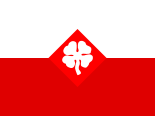Fourth United States Army
| Fourth United States Army | |
|---|---|
|
Fourth United States Army shoulder sleeve insignia | |
| Active |
1932 – July 1971 1984–1992 |
| Country |
|
| Allegiance |
|
| Branch | Regular Army |
| Type | Field army |
| Motto(s) | "Leadership And Integrity" |
| Commanders | |
| Notable commanders |
Alexander Patch Jonathan Wainwright James R. Hall Samuel Tankersley Williams |
| Insignia | |
| Distinctive unit insignia[1] |
 |
| Flag |
 |
The Fourth United States Army was a field army of the United States Army.
History
It was organized as Fourth Army in the Organized Reserves in 1922 at New York City, NY. It was withdrawn from the Organized Reserves on 9 August 1932 and allotted to the Regular Army as an inactive unit. It was activated 1 October 1933 and headquartered at the Presidio of San Francisco, California. In 1946, the Fourth Army moved its headquarters to Fort Sam Houston in San Antonio, Texas. It was redesignated Fourth United States Army on 1 January 1957.
The Fourth United States Army has no combat record. It remained in the Continental United States during World War II, largely responsible for the defense of the West Coast while training tactical units to operate efficiently in combat when allocated to the various battlefront field armies of the United States.
During the 1960s, the Fourth Army operated "Tigerland", an infantry training school at Louisiana's Fort Polk to prepare new recruits for infantry combat in Vietnam. In July 1971, the Fourth Army was disbanded and consolidated with the Fifth United States Army at Fort Sam Houston.
Between 1984 and 1992, Fort Sheridan served as the headquarters of the Fourth Army and U.S. Army Recruiting Command. During that time, Fort Sheridan was the headquarters for activities at 74 U.S. Army Reserve Centers located in northern Illinois, northwest Indiana, and the lower peninsula of Michigan. HQ Fourth US Army, was at "The Army's Biggest Little Post", Fort Sheridan.
The Fort was founded in 1887, named for Gen. Philip H. Sheridan, Civil War Union cavalry leader and commanding general of the Army, 1883–1888; It is located on 695 acres on the shore of Lake Michigan, 29 miles north of Chicago loop. The post serves as an Administrative and Logistics Center for Midwest military installations. It was also home of the Army Recruiting Command, US Military Entrance Processing Command, 425th Trans Bde (USAR), Army Readiness Grp., 4th Recruiting Bde and Recruiting Bn, Chicago. Lieutenant General (United States) James R. Hall, served as the last commanding general of Fort Sheridan. In December 1988, the BRAC Commission recommended closure of Fort Sheridan. The BRAC Commission also recommended relocation of the Headquarters, Fourth Army; and the Headquarters, United States Army Recruiting Command to Fort Benjamin Harrison, Indiana.
Past commanders
- George S. Simonds (1936–1938)
- Albert Jesse Bowley, Sr. (1938–1939)
- John L. DeWitt (1939–1943)
- William Hood Simpson (1943–1944)
- John P. Lucas (1944–1945)
- Alexander Patch (1945)
- Jonathan Mayhew Wainwright IV (1946–1947)
- William M. Hoge (1952–1953)
- LeRoy Lutes (1949–1952)
- Samuel Tankersley Williams (1955)
- Donald Prentice Booth (1961–1962)
- George Gavalas III (?–1969)
- Colonel Fremont C Piercefield (1978–1980?)
- James R. Hall (1989–1991) *Served as the last Commanding General, through inactivation.
References
- ↑ The Distinctive Unit Insignia is a gold color metal and enamel device 1 3⁄16 inches (3.02 cm) in height overall consisting of a red enamel square one angle up bearing a white enamel four-leaf clover with stem to base in front of and extending over a blue (ultramarine) enamel disc, between at top and in base arced gold motto scrolls, that at top crossing over the square in front of the angle, curving downward and terminating at the upper sides of the square, and that in base crossing over the square in front of the angle and terminating at the lower sides of the square, the scroll at the top inscribed "Leadership" and that in base "And Integrity" all in red enamel letters. The design was suggested by the shoulder sleeve insignia of the Fourth U.S. Army modified by the white four-leaf clover with stem being placed in front of and over a blue disc which alludes to the waters of the Pacific and Pacific Coast and the bluebonnet, the State flower of Texas. The distinctive unit insignia was originally authorized on 16 January 1969. It was amended on 25 September 1969 to correct the symbolism of the design.
References
- History of the Fourth Army, Jack B. Beardwood, Washington, D.C., 1946 (N.P. Army Ground Force Study No. 18)
External links
- Fourth Army web page at globalsecurity.org
- Unit Profile in Armies, Corps, Divisions and Separate Brigades a publication of the United States Army Center of Military History
- The short film Big Picture: This is Fourth Army is available for free download at the Internet Archive
